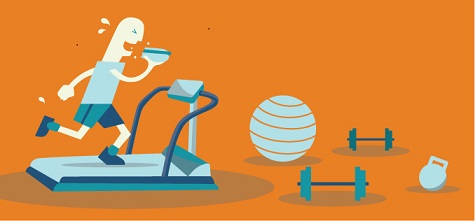You can't outrun a bad diet, authors say
By American Heart Association News

Figure you can eat anything you want as long as you keep going to the gym or maintain a healthy weight?
Think again.
A recent editorial(link opens in new window) in the British Journal of Sports Medicine argued that while exercise is an important tool in reducing the risk of heart disease, Type 2 diabetes and other health conditions, it isn’t enough when it comes to losing weight or staying healthy.
“Let us bust the myth of physical inactivity and obesity. You cannot outrun a bad diet,” the authors wrote.
Reviewing several studies, the authors pointed to misleading marketing messages that suggest all calories are equal and the public perception that obesity is entirely due to a lack of exercise.
Even people at a healthy weight must watch their diet and the authors pointed to studies that suggest up to 40 percent of people with a normal BMI will have metabolic conditions associated with obesity, including heart disease and hypertension.
Exercise and diet are key elements of the American Heart Association’s Life’s Simple 7, a group of seven health factors and behaviors that research has shown contributes to heart health, lowers the risks of heart disease and improves quality of life.
Nearly 70 percent of American adults are either overweight or obese, and as many as 50 percent of Americans don’t get the recommended 150 minutes of moderate physical activity or 75 minutes of vigorous physical activity each week.
“To truly live a healthful lifestyle requires both diet and exercise,” said Deborah Rohm Young, Ph.D, director of behavior research at Kaiser Permanente Southern California. “One can’t take care of the other.”
One reason is that exercise and diet play different and important roles in maintaining health, said Young, who is also the chair of the Physical Activity Committee for the American Heart Associations’ Council on Lifestyle and Cardiometabolic Health.
Physical Activity has many benefits beyond weight control, including strengthening muscles, bone density, diabetes management, and improving mental health. A heart-healthy lifestyle including physical activity and a healthy diet can help reduce heart disease risk factors such as high cholesterol or high blood pressure.
“The benefits of each work on different mechanisms of the body,” Young said.
While exercise is important for maintaining several different components of overall health,, the impact exercise can have is limited if changes aren’t made to a bad diet for people trying to lose weight.
“There’s a lot of denial about how much exercise burns and how many calories are in something,” Young said. “It’s rare to lose weight on an exercise-only program.”
For example, walking three miles burns around 250 to 300 calories. That’s not much when a restaurant meal can easily exceed 1,000 calories, Young said.
“A slice of pizza or bag of Frito’s will easily displace it,” said Young,
For many people, increasing exercise also can lead to an increase in eating, Young said.
“People often feel hungrier or feel they can eat more if they’ve exercised,” she said.
But focusing solely on calories is also a mistake, because not all calories are equal. For example, the calories in a bag of chips don’t include the vitamins and nutrients an equal number of calories of fruits or vegetables, Young said.
“It doesn’t’ matter what your weight status is,” she said. “It’s important to eat a healthful diet.” When it comes to diet, moderation is key, Young said.
“There’s nothing wrong with desserts and chips and other junk food if it’s in moderation,” she said. “It becomes a problem when that type of food becomes the rule rather than the exception.”





